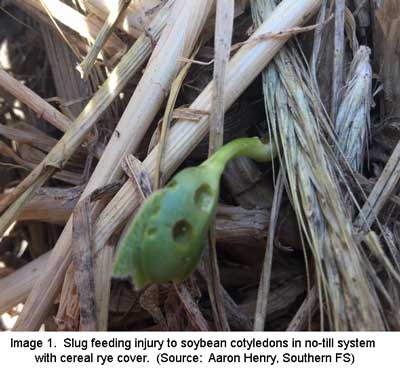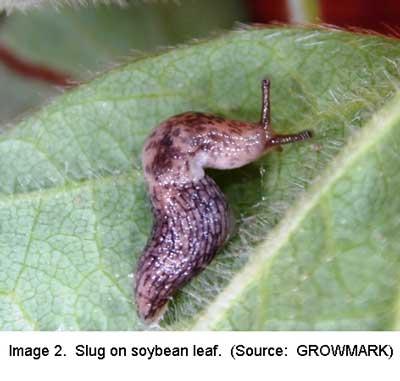
Key Points:
- Slugs are common pests of field crops in the Midwestern US.
- Slugs are favored by plant residues on the soil surface and moist conditions.
- Slugs are foliar feeders and present the most threat to soybeans and corn just after emergence and in early vegetative growth stages.
- Very few chemical control options exist for rescue treatment, possibly necessitating replant in the most severe cases.
Life Cycle and Identification
Slugs are common pests of field crops in the Midwestern US but rarely reach economic thresholds. Slugs are not insects, but instead are gastropods like snails, except without a shell. Slugs are soft-bodied, legless, and shiny, with colors ranging from white to black. They vary in length by species, but most range from ½" to 1 ½". Slugs overwinter as adults and eggs in the soil. Their development is slow and may take more than a year to complete the life cycle. Juveniles resemble adults in appearance. Slugs leave a characteristic shiny slime trail where they travel.
Slugs require moisture to function, so they are favored by reduced tillage or no-till systems with high amounts of crop residue on the surface and moist soil conditions. They may accumulate in numbers in continuous no-till systems, where the soil surface is not periodically disturbed. Cover crops may aggravate slug issues.
Crop Injury and Scouting
Slugs are foliar feeders and present the greatest threat to soybeans and corn shortly after emergence and in early vegetative growth stages. They feed on the lower portions of the plant and may chew holes through the soybean cotyledons or cut the hypocotyl. Stand losses are possible in wet fields. Slugs are most active at night and cloudy days. They can be found hiding under residue, clods, and in open seed furrows during the day. Night sampling may be done with a flashlight by counting slugs that appear on the soil surface.
Management
Cultural methods are the most effective practices for slug control. These include tillage operations to reduce residue build-up, using row cleaners, and avoiding wet planting conditions that leave an open seed furrow. No scientifically validated economic thresholds have been established for slug injury. Some general standards for considering a chemical control would be if the stand is being reduced, slugs are present and actively feeding, and forecasted weather conditions remain favorable to slug activity. Chemical rescue options for slugs are very limited and expensive. Insecticides are ineffective due to the protective layer of slime covering their bodies. Pelleted molluscicides are available, like Deadline M-Ps (metaldehyde from AMVAC) but are difficult to apply uniformly and may not always be labeled for the crop of concern or the state in which you operate. If no chemical products are available for a specific crop in your geography, replant may be the only option. When replanting, consider tillage ahead of the replant operation. Please always read and follow pesticide label directions carefully.
Contact your FS Crop Specialist for your agronomic information.

